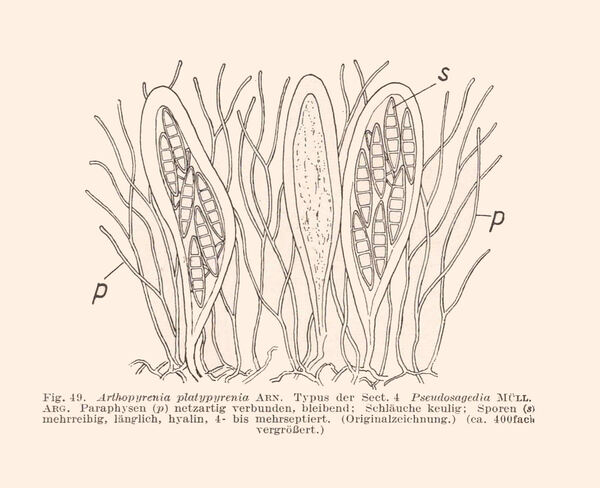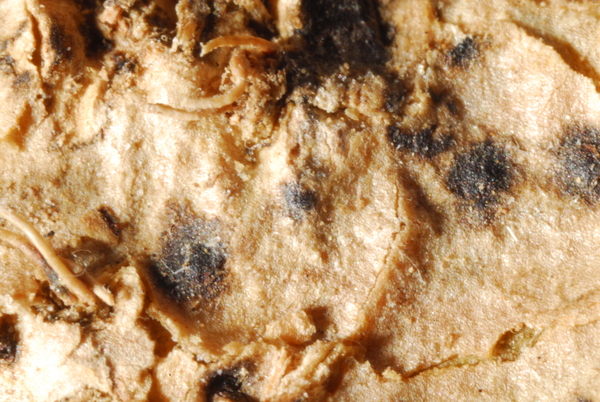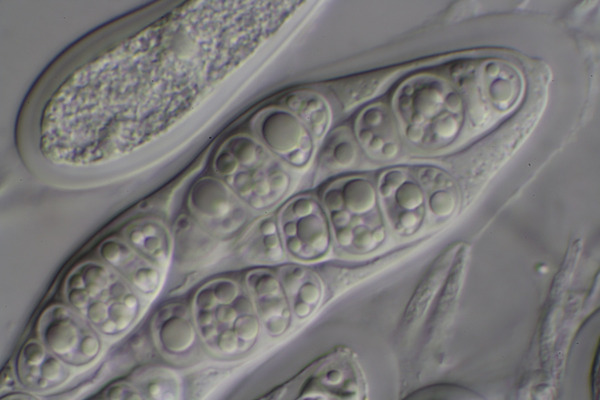Arthopyrenia platypyrenia (Nyl.) Arnold
Flora, 53: 485, 1870. Basionym: Verrucaria platypyrenia Nyl. - Flora, 48: 358, 1865.
Synonyms:
Distribution: C - Tosc (Fačkovcová & al. 2024). S - Cal (Puntillo 1996).
Description: Thallus crustose, endosubstratic, inconspicuous and sometimes evident only as a discolouration of the bark, often surrounded by a thin dark line, not lichenized. Perithecia black, 0.25-0.3 mm across, round in outline, weakly convex with a somehow flattened apical part. Involucrellum dimidiate, small-paraplectenchymatous, dark brown, K-; exciple thin, colourless, surrounding the centrum; pseudoparaphyses well visible in young perithecia, later sometimes disappearing, branched and anastomosing, c. 2 μm thick. Asci 8-spored, clavate, fissitunicate, the endotunica thickened to the apex, c. 60 × 12-18 μm. Ascospores (3-)4-6(-7)-septate, constricted at all septa, hyaline (overmature spores turning brownish), ellipsoid to fusiform-ellipsoid, 24-30 x 8-10(-12) μm, with a 2–3 µm thick gelatinous sheath. Pycnidia black, with a dimidiate wall. Conidia bacilliform, straight, 3-5 1-1.5 μm. Photobiont absent. Spot tests: thallus K-, C-, KC-, P-, UV-. Chemistry: without lichen substances. Note: a non-lichenised fungus of uncertain affinity, known from Ireland, on Hedera. The Italian record from Calabria, confirmed by B. Coppins, was the first in this century.
Growth form: Fungus
Substrata: bark
Reproductive strategy: mainly sexual
Most common in areas with a humid-warm climate (e.g. most of Tyrrenian Italy)
Commonnes-rarity: (info)
Alpine belt: absent
Subalpine belt: absent
Oromediterranean belt: absent
Montane belt: absent
Submediterranean belt: absent
Padanian area: absent
Humid submediterranean belt: extremely rare
Humid mediterranean belt: extremely rare
Dry mediterranean belt: absent

Predictive model
Herbarium samples

PHoto uploaded by P. Cannon - CC BY-SA NC - Source: http://fungi.myspecies.info/all-fungi/arthopyrenia-platypyrenia

Source: Keissler K. von 1938. Pyrenulaceae, Mycoporaceae, Coniocarpineae. In: Rabenhorst G L: Kryptogamen-Flora von Deutschland, Österreich und der Schweiz. 2nd, IX, Die Flechten, Abt. 1, 2. Gebr. Borntraeger, Leipzig, pp. 1-846.
Growth form: Fungus
Substrata: bark
Reproductive strategy: mainly sexual
Most common in areas with a humid-warm climate (e.g. most of Tyrrenian Italy)
Commonnes-rarity: (info)
Alpine belt: absent
Subalpine belt: absent
Oromediterranean belt: absent
Montane belt: absent
Submediterranean belt: absent
Padanian area: absent
Humid submediterranean belt: extremely rare
Humid mediterranean belt: extremely rare
Dry mediterranean belt: absent

Predictive model
| Herbarium samples |

PHoto uploaded by P. Cannon - CC BY-SA NC - Source: http://fungi.myspecies.info/all-fungi/arthopyrenia-platypyrenia

 INDEX FUNGORUM
INDEX FUNGORUM
 GBIF
GBIF





